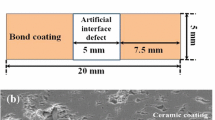Abstract
The development of a successful and accurate instrument for measuring surface-breaking cracks in metals using the ac field technique has raised several interesting theoretical problems. Measurements with the instrument, known as the Crack Microgauge, do not rely on any prior calibration against an artificial flaw such as a saw-cut in a test block, but some users accustomed to such a calibration from other devices have nevertheless wished to use the instrument in that fashion and have in some instances reported erroneous results. In this paper, we develop a simple theory to explain and quantify this phenomenon. We calculate the parasitic voltages induced in the instrument probe due to the finite opening possessed by an artificial flaw, and we use these results to reinterpret the instrument readings. Controlled experimental measurements on artificial flaws of rectangular cross-section made in aluminum and in steel are found to be in good agreement with the theory. It is shown, however, that application of the theory requires additional information about the internal phase shift associated with the instrument. To enhance the accuracy of the theory, the effect of the corners of the artificial flaws was also considered, although it was not very influential in this work.
Similar content being viewed by others
References
W. D. Dover, F. D. W. Charlesworth, K. A. Taylor, R. Collins, and D. H. Michael, The use of a.c. field measurements to determine the shape and size of a crack in a metal, inEddy Current Characterisation of Material and Structures, G. Birnbaum and G. Free, eds., ASTM STP 722 (American Society for Testing and Materials, Philadelphia, 1981), pp. 401–427.
W. D. Dover, F. D. W. Charlesworth, K. A. Taylor, R. Collins, and D. H. Michael, A.c. field measurement—theory and practice, inThe Measurement of Crack Length and Shape During Fracture and Fatigue, C. J. Beevers, ed. (Engineering Materials Advisory Service, Warley, U.K., 1980), pp. 222–260.
R. Collins, D. H. Michael, and K. B. Ranger, The a.c. field around a semielliptical crack in a metal surface, 13th Symposium on Nondestructive Evaluation, San Antonio, Texas, April 1981.
D. H. Michael, R. T. Waechter, and R. Collins, The measurement of surface cracks in metals using a.c. electric fields,Proc. Roy. Soc. A. 381:139–157 (1982).
B. A. Auld, F. Muennemann, and D. K. Winslow, Observation of fatigue crack closure effects with the ferromagnetic resonance eddy current probe,J. Nondestr. Eval.,2:1–21 (1981).
A. H. Kahn, R. Spal, and A. Feldman, Eddy-current losses due to a surface crack in conducting material,J. Appl, Phys. 48:4454–4459 (1977).
A. H. Kahn, Impedance changes produced by a crack in a plane surface, AF/DARPA Review of Progression Quantitative NDE, University of Colorado, Boulder, August 1981.
Author information
Authors and Affiliations
Rights and permissions
About this article
Cite this article
Mirshekar-Syahkal, D., Michael, D.H. & Collins, R. Parasitic voltages induced by artificial flaws when measured using the ac field technique. J Nondestruct Eval 2, 195–202 (1981). https://doi.org/10.1007/BF00570731
Received:
Revised:
Issue Date:
DOI: https://doi.org/10.1007/BF00570731




